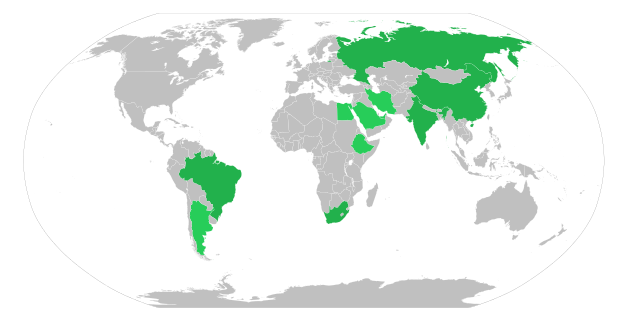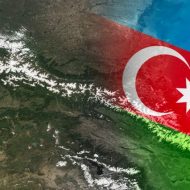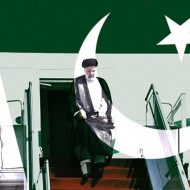By Raphael Machado*
If all goes well, and the countries in question confirm their acceptance of membership, they will officially form part of the bloc as of January 1, 2024.
Therefore, we must begin to think about how Brazil and Argentina, the two representatives of Our America in the bloc, could take advantage of their participation in the BRICS for the more general purpose of accelerating the transformation of Our America into a pole of the future multipolar world.
For this to happen, first, we must hope that the eventual winner of the Argentine presidential elections does not withdraw the country from the bloc in case of confirming its adhesion. Unfortunately, two of the three main candidates have already publicly opposed Argentina’s entry into the BRICS, what clearly does not favor Argentine interests or the multipolar project in general.
We point out here that in the Brazilian case, the commitment to the BRICS has become a state policy, beyond occasional governments, so that we have even seen a bolder approach at a time of international tension under the Bolsonaro government (when he appointed Carlos França as Foreign Minister in place of the Atlanticist Ernesto Araújo), which continued under Lula despite many attempts at sabotage and pressure, including from the government’s own allies.
In this sense, regarding the role of Brazil and Argentina in the BRICS, the joint presence of both countries can and should be used in favor of the project of continental integration.
Therefore, it is necessary to resume continental debates on South America’s participation in the Belt and Road Initiative. The plans that involve the construction and expansion of ports, as well as the multiplication of railways on the continent, with the aim of uniting the Atlantic with the Pacific through the center of the continent, facilitating the flow of products for international trade, must imply also continental integration through a railway network.
Europe was already fully connected by a railway network in the 19th century, as was North America. China, throughout the 20th century, not only connected its entire country by railway lines, but also linked it with Southeast Asia. South America was left behind. In fact, a historical cartographic analysis of the railway networks of the countries of Our America shows that in practically all of them the network has not only not increased, but rather has decreased.
The Belt and Road Initiative, if expanded to include Brazil and Argentina, as well as their neighbors, could allow the simultaneous integration of the Amazon and Patagonia into their respective centers of power, precisely the two regions most threatened by the de-sovereignty strategies directed by the Atlanticist West against our countries through NGOs.
Here, however, it is important to note that the main parts of this project are the Bi-Oceanic Corridor and the Transoceanic Railway: the first consisting of a highway that will link the Port of Santos with the Port of Antofagasta in Chile, also passing through Paraguay and Argentina; the second, a railway that will link the Port of Açu in Rio de Janeiro with a Peruvian port that has not yet been defined. But the first is advancing slowly, and the second has been paralyzed for more than seven years, having encountered countless obstacles, from the ill will of governments to the opposition of NGOs and international interests.
Greater support from China (and why not, from the other BRICS partners, new and old) is needed to speed up the works of the Bi-Oceanic Corridor and really get the Trans-Oceanic Railroad up and running. Based on these infrastructure lines, especially the second, it will be possible to launch a railway network as integrated as the European one, uniting all the micro-regions of our continent. The BRICS Bank (currently run by a Brazilian, by the way) should play an important role in promoting these projects, even investing money not in dollars, but in Brazilian reais (I exclude here, for the moment, the use of the Argentina peso due to the current fragility of the currency).
A second strategically fundamental area is energy. But here I would like to focus first specifically on the nuclear sector.
Brazil currently has two active nuclear reactors, which generate 3% of its energy consumption, while Argentina has three reactors that generate 6% of its energy consumption. Both countries have promoted closer cooperation between their nuclear energy agencies with Russia’s Rosatom and China’s CNNC.
Unfortunately, this is still a rather timid level of commitment to nuclear power. Compare, for example, with China (54 reactors, 5% of consumption), Russia (37 reactors, 20% of consumption) and India (19 reactors, 3% of consumption). South Africa and the other countries that could join the BRICS early next year have an even lower level of nuclear power development than we do.
This is an opportunity for the BRICS to come up with their own response to “climate issues”, their own version of the much-vaunted “energy transition” agenda. Not betting on exotic, dubious and ecologically suspicious sources of energy (let’s not forget that solar batteries depend on lithium and rare metals, and wind propellers cause irreparable damage to fauna), but betting on nuclear energy. Despite the alarmist talk of Netflix (which seems to produce series about nuclear disasters every two years), for most countries, including Brazil and Argentina, nuclear energy is one of the safest, and its efficiency is unrivaled. We are no longer in the 80s, nor in an area of the globe where earthquakes are as frequent as in Japan.
Nuclear power is an indispensable part of “adult environmentalism,” for those who really want to develop their countries efficiently while causing minimal damage to the environment. Unlike the nihilistic and anti-human eco-globalism of the Gretas, who coexist suspiciously with billionaire lobbies and capitalist mega-corporations (all of them large donors to First World environmental NGOs).
However, beyond nuclear energy, it is obvious that the entry of Iran, Saudi Arabia and the United Arab Emirates transforms the BRICS into an oil power, responsible for 45% of the world’s supply of the product. In fact, the BRICS have practically become a new OPEC, with a direct and disproportionate influence on oil prices. This will become even clearer with the possible entry of Venezuela into the bloc, defended by many in the medium term, and also with the possible exploitation of the Equatorial Margin by Brazil. Argentina has also recently discovered new oil reserves in Patagonia, which will also help turn the BRICS into true oil controllers.
This, as we know, will allow the countries in question to combine the most convenient prices for their economies, as well as accelerate the decoupling of oil from the dollar, burying the petrodollar, “ballast” of the modern capitalist economy, with the help of the Bank of BRICS.
In this sense, it should also be stressed that de-dollarization is an important issue for us. And if it is for Brazil, it is even more so for Argentina. The Argentine economy has been partially dollarized since Carlos Menem, which in any case practically prevents the country from having monetary and, therefore, financial sovereignty. Without this sovereignty, the Argentine economy fluctuates based on the decisions of the US Federal Reserve, making the country ungovernable.
Getting the country off this path will be very difficult. In practice, without the help of other economies, it will be impossible for Argentina to get rid of the instability intrinsic to dollarization. Reducing the role of the dollar in the Argentine economy can be done slowly by diversifying available currencies, such as the yuan, while Argentina regains the power and stability of the peso. In fact, the president of the BRICS Bank, Dilma Rousseff, has even announced that the bank will issue in Brazilian real and South African rand, expanding the range of possibilities for a relativization of the power of the dollar.
However, it should be noted that many of the aforementioned possibilities have historically been paralyzed or are currently paralyzed thanks to the intellectual and cultural influence that the West exerts on Brazil and Argentina through academia, the media (mainstream and independent) and especially NGOs.
Especially when it comes to carrying out infrastructure projects, the main obstacles have always been the joint actions of Open Society grant recipients and the US State Department with the local judiciary, all supported by the media.
In this sense, it seems clear to me that no truly sovereign project will advance on our continent unless Russia and China, in particular, begin to invest to counteract Atlanticist influence in Our America. And the power of money invested in Cypriots can only be confronted by the power of money invested in patriotic, counter-hegemonic and multipolar initiatives.
This is not in order to promote Russian or Chinese interests here, but because a true multipolarity will only be possible with the liberation of our civilization.
* Graduate in Law from the Federal University of Rio de Janeiro, President of the Associação Nova Resistência, geopolitical scientist and political scientist, translator for Editora Ars Regia, collaborator of RT, Sputnik and TeleSur.
Previously published in Spanish on Pia Global here, translation by UWI.









Leave a Reply